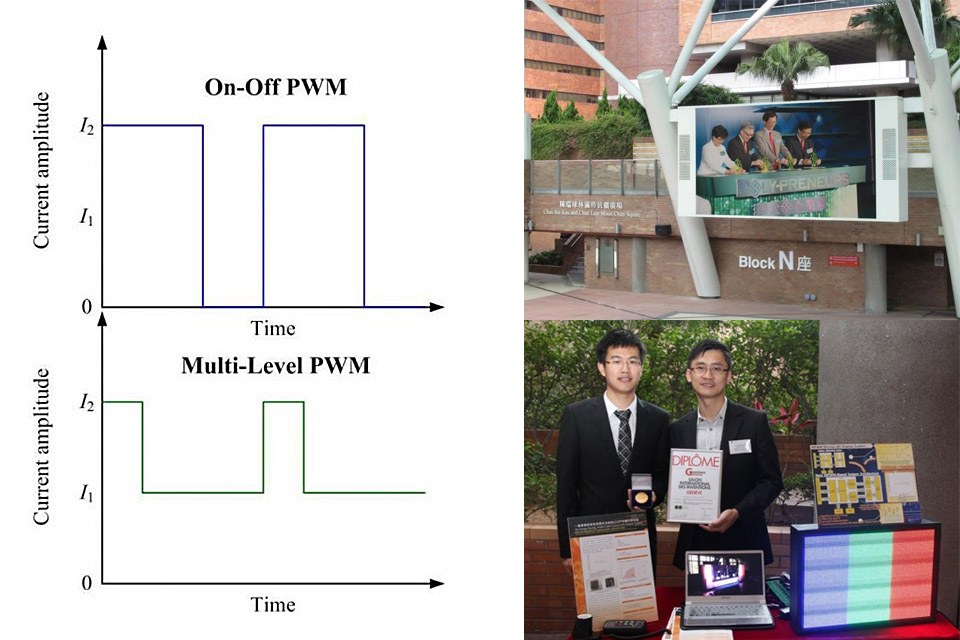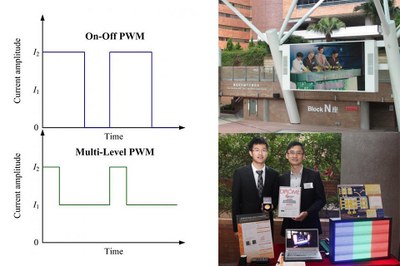Researchers from Hong Kong Polytechnic University Propose Multi-Level PWM To Improving LED System Efficiency
LED light bulbs can be brighter and more energy efficient than ever, thanks to a high performance LED driver newly developed by researchers from the Department of Electronic and Information Engineering.
The new driver powers LED light bulbs with an innovative approach called multi-level PWM (Pulse-Width Modulation), which delivers remarkable improvements in terms of light quality and energy efficiency, when compared to pulse width modulation and linear driver approaches currently used in LED products. This approach is not limited to LED drivers and offers additional advantages and options over conventional PWM or contsnt current mode.
By traditional method of pulse width modulation, LEDs are fed pulsed current instead of steady DC. The drive current is turned ON and OFF at a rate faster than being perceptible by human eyes. Powering LEDs in pulses makes their light output easily controllable.
The research team, formed by Dr Lai Yuk Ming, Dr Loo Ka Hong and Prof. Michael Tse, gives the PWM method a new twist. The pulsed operation is redesigned in a way to maximize light output while minimizing wasted energy in the form of heat. The result is higher lumen per watt. Dr Loo Ka Hong said they achieved additional energy saving by up to 15%.
When used in a large scale application, it can save a lot of energy. The LED billboard on One Times Square in New York is a good example. The math goes like this: The giant display uses 12 million bulbs and 250 KW of power. If the billboard is on for 16 hours a day, the energy bill comes to US$18,000 a month. A 12% drop in energy consumption means US$2,160 in energy savings. That’s something to roll your eyes at.
Furthermore, it has lowered cooling requirements and needs smaller size heat sink compared to conventional methods. That means LED systems can be made smaller. With excellent dimming capability, the new MPWM driver allows manufacturers to create fully dimmable LEDs, which can be dimmed down to 0 watt of power. These superior qualities pave way for brighter, smarter and more versatile LED lighting solutions.
The world is switching to LEDs for huge environmental benefits. If all the traditional light bulbs in the world were replaced with energy-saving ones, lighting energy use could be cut by 40%, according to Worldwatch Institute [1]. The Energy Saving Trust has similar projections [2], which said the resultant carbon saving would be the equivalent of taking 70,000 cars off the road.
As the greenest alternative to incandescent lamps, LEDs are a popular choice of lighting but they are not perfect. Consumers are looking for a brighter and more natural glow matching up to incandescent light bulbs. The demand for brightness is even more pronounced in high power applications such as automobile headlights and architectural lightings. LED research worldwide is looking to build a perfect substitute to incandescent. It is exciting to have advanced LED lighting with a simple solution such as MPWM that brings about significant energy saving.
Obviously, the novel technology allows a better product to be made. High illuminating performance combined with good thermal protection allowed manufacturers to create compact lighting solutions with a very high lumen output. And the additional cost is little because all of these qualities could be achieved with the use of low cost ICs. This could be music to the ear for LED manufacturers.
This innovative applied technology has already aroused the attention of the international market. Recently it has won a Gold Award at the 41st International Exhibition of Inventions of Geneva in April of 2013.


